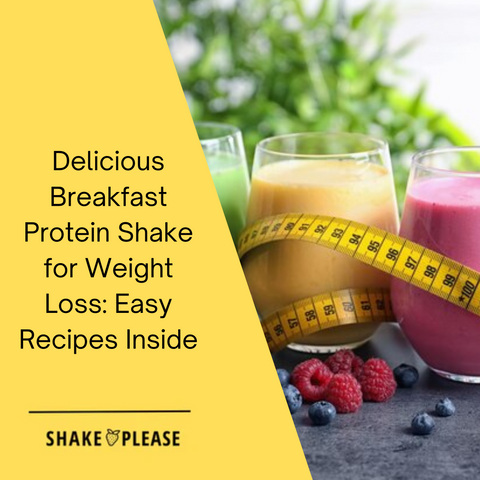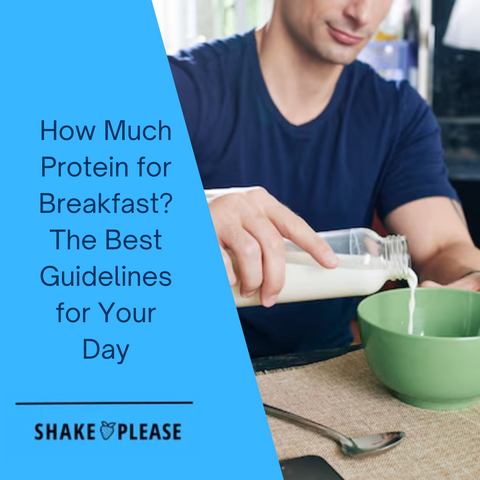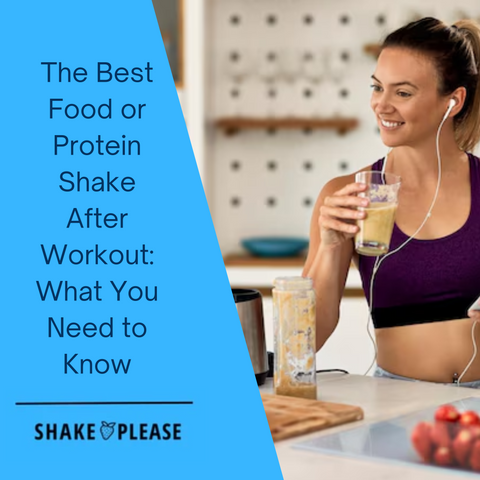
Why Protein Shakes are Important for Weight Loss
Protein shakes are powerful tools for weight loss. They offer a convenient, filling, and nutritious way to control hunger, boost metabolism, lose weight, and preserve muscle mass. Unlike carb-heavy breakfasts that can lead to energy crashes, protein shakes help maintain steady energy levels while supporting fat loss and maintaining muscle mass maintenance.
Boosts Metabolism and Satiety
1. Increases Protein Intake to Burn More Fat
Protein has a high thermic effect and slow digestion, meaning the body burns more calories digesting it compared to carbs or fats. Increasing protein intake through shakes can support fat loss and excess weight by keeping metabolism active.
2. Helps Reduce Hunger and Cravings
High-protein meals and shakes increase satiety hormones while lowering ghrelin (the hunger hormone), making you feel full longer. This helps control cravings and snacking, reducing overall calorie intake.
3. Supports Healthy Digestion and Nutrient Absorption
Smoothies made with high-quality protein and fiber-rich ingredients (such as chia seeds, flaxseeds, rolled oats, or spinach) help regulate digestion, reduce bloating, and support gut health—all essential for effective weight loss.
Supports Muscle Growth and Repair
1. Provides Essential Amino Acids for Muscle Recovery
Protein shakes supply the building blocks for muscle tissue repair and growth. This is especially important when cutting calories, as drinking protein shakes helps prevent muscle loss while losing fat.
2. Promotes Muscle Protein Synthesis
When paired with resistance training, protein shakes stimulate muscle protein synthesis, leading to lean muscle growth, which is because building muscle naturally burns more calories at rest.
3. Supports Overall Muscle Health
Sufficient protein intake ensures that your muscles remain strong, toned, and functional—helping you achieve a leaner physique with more muscle rather than just losing your body weight alone.
Convenient and Easy to Prepare
1. Made in Just a Few Minutes
With just a blender and a few ingredients, you can prepare a complete protein- shake in under five minutes—making it an ideal breakfast or snack option for busy mornings.
2. Great for On-the-Go Nutrition
Protein shakes can be prepped in advance and stored in mason jars or travel cups for a quick, portable meal. Whether you're heading to work, the gym, or running errands, drinking protein shakes will they ensure you stay on track with your nutrition goals.
3. Fully Customizable
-
Prefer a tropical flavor? Add pineapple, coconut milk, and mango.
-
Love chocolate? Blend in cocoa powder, peanut butter, and almond milk.
-
Need extra fiber? Toss in some chia or flaxseeds.
By customizing flavors and nutrients, you can create shakes that are delicious, satisfying, and tailored to your weight loss goals.
Choosing the Right Protein Powder
Selecting the best protein powder is key to maximizing weight loss, muscle growth, and overall, health benefits. With so many options on the market, it’s important to understand the different types of protein, their health benefits, and what to look for on the label.
Types of Protein Powder
1. Whey Protein
-
Fast-digesting, high-quality protein that is rich in essential amino acids.
-
Best for muscle growth, post-workout recovery, and weight management.
-
Derived from dairy, making it unsuitable for lactose-intolerant individuals.
2. Casein Protein
-
Slow-digesting protein that provides a steady release of amino acids.
-
Best for nighttime recovery and reducing muscle breakdown.
-
Keeps you full longer, making it a good option for weight management.
Guide to the Different Types of Protein Powder: Which One is Right for You?
Considerations for Selecting a Protein Powder
1. Protein Content
-
Look for a protein powder with at least 20-25 grams of protein per serving.
-
Check for high-quality protein sources rather than filler ingredients.
2. Ingredient Quality
-
Choose protein powders with minimal artificial additives, sweeteners, or preservatives.
-
Look for products with clean, recognizable ingredients (e.g., “whey protein isolate” vs. “artificial protein blend”).
3. Potential Allergens
-
If you’re lactose intolerant, avoid whey and casein protein and opt for plant-based or lactose-free options.
-
For those with soy or gluten allergies, double-check labels for potential cross-contamination.
-
If you’re vegan, make sure the protein is 100% plant-based.
Tips for Reading Protein Powder Labels
1. Check Protein Content
-
Look at the nutrition facts panel to see how much protein is in one serving.
-
Some protein powders may contain added sugars or fillers, which lower the actual protein content.
2. Review the Ingredient List
-
Fewer ingredients = better quality.
-
Avoid products with artificial colors, flavors, or excessive thickeners.
-
Look for whole food-based ingredients like pea protein, whey isolate, or hemp protein.
3. Understand the Macronutrient Breakdown
-
High protein, low sugar, and moderate healthy fats = best for weight loss.
-
Look for added vitamins, minerals, or digestive enzymes for extra nutritional benefits.
By choosing the right protein powder and carefully reading labels, you can ensure you’re fueling your body with the best ingredients to support healthy weight- loss, muscle growth, and overall wellness.
Easy Breakfast Protein Shake Recipes
Protein shakes are a quick, nutritious, and delicious way to start your day. These easy-to-make breakfast protein shakes provide high-quality protein, essential nutrients, and great flavors to fuel your morning routine.
1. Vanilla Protein Powder with Banana and Almond Milk
-
A classic, smooth, and satisfying protein shake recipe.
-
Ingredients:
-
1 scoop vanilla protein powder
-
1 banana (fresh or frozen)
-
1 cup unsweetened almond milk
-
½ teaspoon cinnamon (optional)
-
3-4 ice cubes
-
-
Why It Works:
-
Provides creamy texture and a natural sweetness from banana.
-
High in potassium, protein, and fiber, making it a balanced breakfast.
-
Great for digestion and energy-boosting throughout the morning.
-
Try an alternative with Vanilla Berry Protein Smoothie, which adds delicious mixed berries plain yogurt for a healthy protein refreshing twist.
👉 Vanilla Berry Protein Smoothie
2. Peanut Butter and Chocolate Protein Shake
-
A rich, indulgent, and protein-packed shake perfect for breakfast or post-workout.
-
Ingredients:
-
1 scoop chocolate protein powder
-
1 tablespoon peanut butter
-
1 cup almond milk (or any milk of choice)
-
½ frozen banana
-
1 teaspoon cocoa powder (for extra chocolate flavor)
-
3-4 ice cubes
-
-
Why It Works:
-
Perfect balance of protein, healthy fats, and fiber.
-
Keeps you full longer, making it a great meal replacement.
-
Satisfies sweet cravings while still being nutritious.
-
Try an alternative with the Chocolate Peanut Butter Banana Protein Smoothie for a ready-to-blend option with a perfect balance of flavor high protein and nutrition.
👉 Chocolate Peanut Butter Banana Protein Smoothie
3. Berry Bliss with Greek Yogurt and Honey
-
A sweet, refreshing, and antioxidant-rich shake.
-
Ingredients:
-
1 scoop vanilla protein powder
-
½ cup frozen mixed berries (blueberries, raspberries, strawberries)
-
½ cup Greek yogurt
-
1 cup unsweetened almond milk
-
1 teaspoon honey
-
3-4 ice cubes
-
-
Why It Works:
-
Loaded with antioxidants, vitamins, and gut-friendly probiotics.
-
Provides a natural boost of energy while keeping you full longer.
-
Perfect for a light and refreshing morning smoothie.
-
For a tropical berry alternative, try the Pineapple Berry Protein Smoothie, packed with pineapple, berries frozen fruit, and plant-based protein for a refreshing kick.
👉 Pineapple Berry Protein Smoothie
Tips for Customizing Your Protein Shake
Protein shakes are highly customizable, allowing you to experiment with flavors, adjust texture, and enhance nutrition to fit your taste and goals.
1. Experiment with Different Flavors and Ingredients
-
Try New Flavors: Swap vanilla for chocolate, peanut butter, or fruit-based flavors.
-
Try New Ingredients: Mix in avocado, oats, or matcha powder for extra nutrients.
-
Keep It Simple: Stick to classic combinations like banana + peanut butter or berry + yogurt for an easy, delicious shake.
2. Adjust the Consistency and Texture
-
More or Less Liquid:
-
Add more milk or water for a thinner shake.
-
Use less liquid for a thicker, creamier consistency.
-
-
Add Ice: Blending with ice cubes makes the shake thicker and colder.
-
Blend Until Smooth: A high-speed blender ensures a creamy and lump-free texture.
3. Add Supplements or Boosters
-
Consider Adding Supplements:
-
Collagen powder for skin and joint health.
-
Creatine for muscle strength and endurance.
-
Superfood powders (like spirulina or matcha) for added antioxidants.
-
-
Choose High-Quality Supplements:
-
Pick products with minimal fillers and artificial additives.
-
-
Follow the Instructions:
-
Some supplements may require specific mixing instructions to dissolve properly.
-
By customizing your protein shake, you can get extra protein to maximize its nutritional value while creating a flavor-packed, satisfying breakfast option!
Common Mistakes to Avoid When Making a Protein Shake
While protein shakes are an excellent way to support weight loss, muscle growth, and overall nutrition, some common mistakes can reduce their effectiveness. Here’s what to avoid to ensure your protein shake is nutrient-dense, balanced, and satisfying.
1. Using Too Much Protein Powder
Adding too much protein powder might seem like a way to increase muscle-building benefits, but it can create an unbalanced, chalky, and hard-to-digest shake.
-
Use the Recommended Amount: Most protein powders recommend 20-25 grams per serving—stick to this to maintain proper nutrition.
-
Avoid Overdoing It: Excessive protein intake won’t necessarily lead to faster muscle growth and may cause bloating or digestive discomfort.
-
Balance the Macronutrients: Ensure your shake has a good mix of protein, healthy fats, and fiber-rich carbohydrates for a well-rounded meal.
2. Not Balancing Macronutrients
A healthy protein and shake should do more than just provide enough protein alone—it should also supply the right balance of carbs, fats, and fiber to keep you full and energized.
-
Add Healthy Carbs: Incorporate fruits like banana or berries, or use oats for sustained energy.
-
Include Healthy Fats: Nut butters, avocado, or flaxseeds provide a creamy texture and nutrient boost.
-
Enhance with Fiber: Chia seeds, hemp seeds, or leafy greens improve digestion and satiety.
Example of a Balanced Shake:
-
1 scoop of Vanilla Berry Protein Smoothie for protein
-
½ frozen banana for natural carbs
-
1 tablespoon of almond butter for healthy fats
3. Adding Too Many Extras and Fillers
While customizing your shake with various ingredients is great, overloading it with unnecessary extras can lead to excess calories and an imbalanced drink.
-
Too Many Sweeteners: Avoid syrups, flavored yogurts, or excessive honey, as they add unnecessary sugar and calories.
-
Overloading on Ingredients: Too many add-ins can make your shake overly thick, high in calories, and difficult to digest.
-
Keep It Simple and Healthy: Stick to a base, a protein source, a fruit or vegetable, and one or two add-ins.
Example of a Simple Yet Nutritious Shake:
-
1 scoop of Chocolate Peanut Butter Banana Protein Smoothie for protein and flavor
-
½ cup of unsweetened almond milk as a liquid base
-
1 teaspoon of cocoa powder for extra depth
Chocolate Peanut Butter Banana Protein Smoothie
By avoiding these common mistakes, you can ensure your protein shake is well-balanced, effective, and enjoyable while supporting your health and fitness goals.
How to Incorporate Protein Shakes into Your Weight Loss Plan
Protein shakes can be an effective tool for weight loss when used strategically. Whether as a meal replacement, pre- or post-workout fuel, or a supplement to a balanced diet, they help support muscle growth, further weight loss diet curb cravings, and maintain energy levels while cutting calories.
1. As a Meal Replacement or Snack
Using protein shakes as a meal replacement or between meals can help control hunger and prevent overeating.
-
Use as a Meal Replacement: A well-balanced protein shake can serve as a substitute for breakfast or lunch, providing essential nutrients while keeping calorie intake in check.
-
Use as a Snack: A protein shake between meals can reduce cravings and prevent unhealthy snacking.
-
Choose a Balanced Shake: Ensure your shake contains protein, healthy fats, and fiber-rich carbohydrates for sustained energy and satiety.
Example of a Balanced Meal Replacement Shake:
-
1 scoop of Pineapple Berry Protein Smoothie
-
½ cup of Greek yogurt for protein and probiotics
-
1 tablespoon of chia seeds for fiber and healthy fats
2. Before or After a Workout
Protein shakes are excellent for fueling workouts and aiding muscle recovery.
-
Before a Workout: Drinking a protein shake 30-60 minutes before exercising provides amino acids for muscle support and energy.
-
After a Workout: A post-workout protein shake helps repair muscle fibers and kickstarts muscle protein synthesis.
-
Choose a Shake with Carbohydrates: Adding a source of carbs, like a banana or oats, replenishes glycogen stores and supports muscle recovery.
Example of a Pre-Workout Shake:
-
1 scoop of Chocolate Peanut Butter Banana Protein Smoothie
-
1 banana for quick-digesting carbs
-
1 cup of unsweetened almond milk for a creamy texture
3. As a Supplement to a Balanced Diet
Protein shakes should complement a healthy diet rather than replace whole foods entirely.
-
Enhance Protein Intake: Use shakes to meet daily protein needs without excessive calories.
-
Pair with Whole Foods: Combine shakes with whole foods like nuts, seeds, and fiber-rich fruits to maximize nutrition.
-
Avoid Relying Solely on Shakes: While they’re convenient, a variety of whole foods ensures long-term health and weight loss success.
By incorporating protein shakes in a strategic way, you can improve satiety, support lean muscle mass preservation, and maintain steady energy levels while staying on track with your weight loss plan.
Is Your Smoothie Packed with Whole Foods?
Maximizing Weight Loss with Protein Shakes
Protein shakes can be a powerful tool for weight loss when combined with the right strategies. By pairing them with a healthy diet and regular exercise, tracking progress, and staying consistent, you can maximize their effectiveness to lose body fat and reach your body fat% goals.
1. Combining Protein Shakes with a Healthy Diet and Exercise
Protein shakes work best when incorporated into a healthy metabolism well-balanced lifestyle.
-
Eat Whole, Nutrient-Dense Foods: Combine shakes with lean proteins, healthy fats, and fiber-rich carbs to support metabolism and satiety.
-
Engage in Regular Exercise: Strength training and cardio complement protein shakes by promoting fat loss and muscle preservation.
-
Avoid Highly Processed Foods: Cutting out sugary drinks, refined carbs, and processed snacks enhances weight loss results.
Example:
Pair a Vanilla Berry Protein Smoothie with a high-protein meal after a workout for sustained energy.
Vanilla Berry Protein Smoothie
2. Monitoring Progress and Adjusting as Needed
Tracking results ensures you’re staying on course and allows for adjustments when necessary.
-
Keep a Food Journal: Track protein intake, meals, and snacks to maintain awareness of eating habits.
-
Adjust Calories and Macros: If weight loss stalls, tweak protein, carb, and fat intake to optimize results.
-
Assess Energy Levels and Satiety: Make sure shakes keep you full and energized without excessive cravings.
3. Staying Motivated and Consistent
Weight loss is a long-term commitment, and consistency is key to weight loss maintenance success.
-
Set Realistic Goals: Focus on gradual, sustainable progress rather than quick fixes.
-
Stick to a Routine: Making protein shakes a daily habit simplifies healthy eating.
-
Celebrate Small Wins: Acknowledge progress, whether it’s weight loss, muscle tone, or increased energy.
Conclusion
Breakfast protein shakes are a simple, effective way to support your weight loss journey by boosting metabolism, promoting satiety, and providing essential nutrients. By combining them with a balanced diet, exercise, and consistent habits, you can achieve long-term results.
Try out the recipes and tips in this guide to start seeing the benefits for yourself. For more resources on healthy eating and weight loss, explore: high protein diets full-protein meal plans high protein diets, fitness guides, and nutritional advice to stay on track with your goals.





